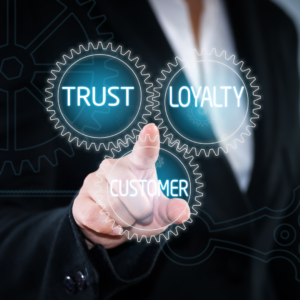
The Future of Secure and Compliant Data Analytics with Data Clean Rooms.
Introduction
Digital progress should not come at the expense of privacy and security. Privacy is not for sale; it is a valuable asset to protect. At a time when data breaches regularly make headlines and consumer privacy concerns are at an all-time high, data privacy has become even more complex.
According to a 2023 report from IBM, the global average cost of a data breach has climbed to $4.45 million, highlighting the high stakes in data management today.
Enter Data Clean Rooms, a solution that redefines the boundaries of secure data analytics. Essentially, a Data Clean Room is a secure environment that allows different data sets to be aggregated and analyzed without direct access to the underlying data itself. This means that sensitive consumer information is anonymized and protected, ensuring compliance with strict data privacy regulations such as GDPR and CCPA.
The implications of this technology are profound for brands. In a data-driven marketplace, the ability to swiftly and safely harness insights from consumer data can be the difference between leading the market or lagging.
Data Clean Rooms offer a way to navigate the twin challenges of data utility and user privacy. They provide a platform where strategic decisions can be informed by comprehensive analytics without risking consumer trust or violating regulatory mandates.
Data Clean Rooms are not just a compliance necessity but a strategic asset. They revolutionize how brands access, analyze and leverage consumer data to make smarter, faster business decisions while staying within the legal frameworks of global data privacy laws.
The Rise of Data Privacy Concerns
As brands increasingly leverage data to drive decisions, it is crucial to understand how data privacy regulations and consumer expectations are evolving.
Here’s a quick look at Global Data Privacy Regulations:
- General Data Protection Regulation (GDPR): Enacted in the European Union in 2018, GDPR has set the benchmark for data privacy, imposing strict rules on data consent, transparency, and the right to be forgotten.
- California Consumer Privacy Act (CCPA): Similar to GDPR, the CCPA, which took effect in 2020, gives California residents the right to know about and control the personal information businesses collect about them.
Other Global Regulations: From Brazil’s LGPD to China’s PIPL, countries worldwide are implementing stringent data protection laws that impact the global operations of all companies.

According to a Research, 79% of consumers are concerned about how companies use their data
Impact of these regulations on traditional data analytics practices:
- Restrictions on Data Access and Usage: Regulations like GDPR and CCPA restrict how brands collect and use personal data, requiring more stringent consent mechanisms and transparency.
- Increased Compliance Costs: The need for compliance has increased business operational costs. Companies need robust systems and processes to manage, secure, and audit data effectively.
Shift Toward Privacy by Design: There’s a growing need for analytics tools and processes that inherently respect user privacy, prompting a reevaluation of traditional data analytics models.
According to a Research, 88% of users’ willingness to share personal data depends on how much they trust a company.
Consumer attitudes towards data privacy and how it affects brand loyalty and trust:
- Growing Consumer Awareness: Many studies have shown consumers are concerned about how brands use their data.
- Impact on Brand Loyalty: Consumers increasingly favor brands that can prove they handle data ethically. According to a Salesforce report, 88% of customers say their trust in a company is a factor in their purchasing decisions.
- Demand for Transparency: There is an apparent demand for greater transparency in how personal data is used, with consumers advocating for more control over their information.
What Are Data Clean Rooms?
As the digital economy grows, so does the need for advanced data management solutions. Data Clean Rooms have emerged as a pivotal tool for secure data analytics, allowing brands to maximize data utility while adhering to stringent privacy regulations.
Investing in Data Clean Rooms is investing in the future of ethical, transparent data use.
Definition of Data Clean Rooms
A Data Clean Room is a secure digital environment where data from multiple sources can be brought together, analyzed, and processed without exposing the raw data to any of the parties involved. It acts as a neutral space that ensures the privacy and security of data by allowing only aggregated or anonymized data outputs, thus preventing any unauthorized access to sensitive or personally identifiable information.
Key Features of Data Clean Rooms
- Isolation: Data Clean Rooms operate in a controlled environment isolated from other data processes and systems. This isolation helps mitigate risks related to data breaches or unauthorized data access.
- Non-sharing of Raw Data: One of the fundamental principles of Data Clean Rooms is that raw data from one party is never directly shared with another. This ensures compliance with data protection laws by minimizing the risk of data misuse.
- Use of Aggregated Data: In Data Clean Rooms, data is aggregated or processed to a level where individual data points cannot be linked back to any specific individual, thereby adhering to privacy standards.
Types of Data Clean Rooms
- Vendor-specific Data Clean Rooms: These are provided by vendors offering additional tools and services for data analysis. Companies like Google and Facebook have their versions, optimized to work with their respective advertising and analytics data.
- Neutral, Cloud-based Options: Independent providers offer neutral Data Clean Rooms not tied to a specific platform’s ecosystem. These providers ensure a level playing field where data from various sources can be analyzed without the influence or control of a dominant vendor.
Benefits of Data Clean Rooms for Brands
Data Clean Rooms are rapidly becoming a crucial data strategy for brands across industries.
Here are some key benefits that these secure environments provide:
- Secure Data Sharing Without Compromising Individual Privacy
- Privacy Preservation: Data Clean Rooms allow for data integration and analysis without exposing individual data points. This method supports data-driven initiatives while upholding the privacy of the data subjects.
- Controlled Access: Access to the data within these rooms is tightly controlled and monitored, ensuring that only authorized personnel can view or analyze the data and only in the aggregate or anonymized form.
- Enhanced Compliance with Data Protection Regulations
- Regulatory Alignment: By design, Data Clean Rooms help brands comply with stringent data protection laws, such as GDPR and CCPA, by ensuring that data handling and processing meet legal standards.
- Audit Trails: These environments often include robust audit trails, which help brands demonstrate compliance with data protection regulations during audits or inspections.
- Improved Accuracy and Reliability of Data Analytics Through Controlled Environments
- Standardized Environments: Data Clean Rooms provide a standardized environment where data from various sources can be analyzed consistently. This standardization helps reduce discrepancies and improve the reliability of data analytics.
- Reduced Data Contamination: The isolated nature of Data Clean Rooms prevents the contamination of datasets by external variables, leading to more accurate and reliable analytics outcomes.
A 2022 Salesforce report states that 88% of customers believe trust is a factor in their purchase decisions, and it becomes even more critical in times of change.
How Brands in Major Industries Are Using Data Clean Rooms Effectively
- Retail and Consumer Goods: Major international retailers use a Data Clean Room to safely combine their sales data with third-party demographic data to refine their product placement strategies across different regions without exposing individual consumer data.
- Entertainment and Media: A global streaming service can implement a Data Clean Room to analyze viewership data across different platforms and geographies. This can enable them to obtain insights about viewing habits and preferences while ensuring compliance with global data privacy laws.
How Data Clean Rooms Work
Data Clean Rooms are complex yet elegantly designed environments that provide secure and compliant data analytics capabilities. Understanding the infrastructure and process behind these tools is critical for brands aiming to leverage their potential.

Technical Overview of the Infrastructure
- Secure Environment: Data Clean Rooms are hosted in highly secure, often cloud-based environments. These platforms are built with robust security measures, including encrypted data storage, secure data transmission, and stringent access controls.
- Dedicated Hardware and Software: The infrastructure typically involves dedicated hardware for data processing that ensures high performance and isolation from external systems. The software specializes in handling large datasets and complex analytics functions while ensuring data integrity and security.
- Data Entry
- Data providers upload their datasets to a secure environment. This data is typically encrypted both in transit and at rest.
- Data is anonymized or de-identified upon entry, ensuring no sensitive information is accessible.
- Data Integration and Preparation
- Data from multiple sources is integrated. This may involve matching datasets using non-identifiable data points.
- The data is cleaned and transformed to ensure consistency and readiness for analysis.
- Data Analysis
- Users query the data through controlled interfaces that enforce data usage rules, ensuring that only non-identifiable, aggregated results are returned.
- Complex analytics, machine learning models, or statistical analyses are applied to the integrated datasets.
- Output Generation
- The analysis results are generated in an aggregated or otherwise non-identifiable format. Direct access to raw data is never permitted.
- Differential Privacy: This technique adds randomness to the datasets or queries to ensure individual data points cannot be identified, thus enhancing privacy.
- Synthetic Data: In some cases, synthetic datasets are generated from the original data. These datasets mimic the statistical properties of the original data but do not contain any user information, allowing for risk-free data analysis.
- Secure Multi-party Computation (SMPC): This cryptographic method allows multiple parties to jointly compute a function over their inputs while keeping those inputs private. This is particularly useful in Data Clean Rooms, where data from different sources needs to be analyzed without actual data exchange.
- Differential Privacy: This technique adds randomness to the datasets or queries to ensure individual data points cannot be identified, thus enhancing privacy.
- Synthetic Data: In some cases, synthetic datasets are generated from the original data. These datasets mimic the statistical properties of the original data but do not contain any user information, allowing for risk-free data analysis.
- Secure Multi-party Computation (SMPC): This cryptographic method allows multiple parties to jointly compute a function over their inputs while keeping those inputs private. This is particularly useful in Data Clean Rooms, where data from different sources needs to be analyzed without actual data exchange.
- Outputs are scrutinized to ensure they do not reveal individual data points before being made available to end-users.
Step-by-Step Process from Data Entry to Data Analysis
Algorithms and Technologies Used for Data Clean Rooms
- Differential Privacy: This technique adds randomness to the datasets or queries to ensure individual data points cannot be identified, thus enhancing privacy.
- Synthetic Data: In some cases, synthetic datasets are generated from the original data. These datasets mimic the statistical properties of the original data but do not contain any user information, allowing for risk-free data analysis.
- Secure Multi-party Computation (SMPC): This cryptographic method allows multiple parties to jointly compute a function over their inputs while keeping those inputs private. This is particularly useful in Data Clean Rooms, where data from different sources needs to be analyzed without actual data exchange.
on of proprietary data and industry expertise that’s delivering the market-leading insights fuelling innovation and unparalleled competitive edge. This is the deciding factor in who leads and who follows in the AI-driven future of market research and brand growth.
Challenges and Considerations to Set Up Data Clean Rooms
While Data Clean Rooms offer substantial benefits for secure and compliant data analytics, they also present challenges and considerations that brands must navigate. Understanding these complexities is crucial for organizations considering their implementation.
Technical and Logistical Challenges in Setting Up and Maintaining a Data Clean Room
- Infrastructure Complexity: Establishing the necessary infrastructure for a Data Clean Room requires significant expertise in both hardware and software. Brands must ensure that the infrastructure is robust enough to handle large volumes of data securely and efficiently.
- Integration Issues: Integrating data from various sources into a Data Clean Room can be complex, especially when dealing with different data formats and structures. Ensuring data consistency and accuracy during integration poses a significant challenge.
- Maintaining Privacy Standards: Continuously updating and maintaining privacy standards in the Clean Room environment, especially as data privacy regulations evolve, requires ongoing vigilance and resources.
Costs/ Benefits Analysis for Small vs. Large Enterprises
Large Enterprises
- Benefits: For large enterprises, the scale of data operations often justifies the investment in Data Clean Rooms. The ability to safely utilize large datasets can lead to significant competitive advantages.
- Costs: The financial outlay for setting up and maintaining a Data Clean Room can be substantial, including the costs of technology, personnel, and ongoing compliance.
Small Enterprises
- Benefits: Small enterprises can benefit from the enhanced trust and compliance posture that Data Clean Rooms offer, which might be critical in regulated industries.
- Costs: Setting up a Data Clean Room may be cost-prohibitive for smaller players. However, cloud-based solutions and as-a-service offerings are emerging as cost-effective alternatives allowing smaller companies to leverage this technology without needing significant upfront investments.
Limitations in Data Usability and Interaction
- Data Siloing: While Data Clean Rooms secure data and ensure compliance, they can also lead to data siloing within the organization. This can limit teams’ ability to perform cross-functional analyses that require more holistic data views.
- Reduced Flexibility: The stringent controls necessary for privacy and security in Data Clean Rooms can sometimes reduce the flexibility of data analysis. Analysts may be unable to perform certain types of analyses due to the limitations on how data can be viewed or combined.
- Dependence on Aggregated Data: Relying primarily on aggregated data can obscure the nuances that individual-level data provides. This might lead to less precision in insights, particularly in scenarios where granular data is critical for decision-making.
While Data Clean Rooms provide a powerful tool for secure data analytics, they require careful consideration of the technical, financial, and operational challenges. Organizations must weigh these factors against the potential benefits to determine the viability of implementing a Data Clean Room in their data strategy.
Best Practices for Implementing Data Clean Rooms
Successfully implementing a Data Clean Room involves strategic planning and adherence to best practices. Here, we detail essential strategies for effective data management, ensuring scalability, and maintaining compliance—all critical for leveraging the full potential of Data Clean Rooms.
The right to privacy in the digital age is paramount. Data Clean Rooms ensure this right while allowing brands to innovate responsibly.
Strategies for Effective Data Management within a Clean Room
- Data Standardization: Implementing rigorous data standardization protocols ensures compatibility between data from different sources within the Data Clean Room. This includes standardizing formats, labels, and other metadata.
- Quality Control: Regular checks and balances should be established to maintain data integrity. This involves routine audits of the data inputs and outputs within the Clean Room to detect and rectify any inconsistencies or errors.
- Access Controls: Strict access controls and role-based access should be enforced to ensure that only authorized personnel have access to specific data and analytics tools within the Data Clean Room.
Ensuring Scalability and Flexibility to Adapt to Evolving Data Needs
- Modular Infrastructure: Design the Data Clean Room architecture to be modular, allowing components to be added or modified as data needs evolve without disrupting existing operations.
- Elastic Resources: Utilize cloud-based services that offer elastic resources to handle fluctuations in data processing demands. This ensures that the Data Clean Room can scale up or down based on real-time needs, optimizing cost and performance.
- Future-proof Technologies: Invest in adaptable and forward-looking technologies, considering potential changes in data types, analytics methodologies, and regulatory landscapes.
What Brands Need to Know Before Setting Up a Data Clean Room
- Understand Applicable Regulations: Brands must be thoroughly familiar with data protection laws that apply to their operations, such as GDPR, CCPA, etc. This understanding will dictate critical aspects of Data Clean Room setup and operation.
- Data Minimization Principles: Ensure that the data collected and processed in the Clean Room adheres to the principle of data minimization—only processing the data necessary for specific purposes.
- Regular Compliance Audits: Establish a routine for regular compliance audits to ensure that the Data Clean Room meets evolving data privacy laws and industry standards.
- Incident Response Plan: Develop and maintain a robust incident response plan tailored to the Data Clean Room. This plan should outline procedures for addressing data breaches or compliance issues, including notification protocols and mitigation strategies.
The Future of Data Clean Rooms in Market Research
Data Clean Rooms are set to play an increasingly critical role in market research as technology advances and the demand for secure, sophisticated data analysis grows.
Here’s how experts predict these environments will evolve and expand their impact across various industries.
How Data Clean Rooms Will Evolve with Advancing Technology
- Integration with Emerging Technologies: As blockchain and advanced encryption methods mature, expect to see these technologies integrated into Data Clean Rooms to enhance security and data integrity further.
- Increased Automation: Future iterations of Data Clean Rooms will likely feature greater levels of automation in data handling and analysis processes, reducing the need for manual intervention and speeding up insights generation.
- Enhanced Real-time Capabilities: Technological advancements will enable more dynamic and real-time data analysis within Clean Rooms, allowing brands to make faster and more accurate decisions based on the latest data.
The Role of AI and Machine Learning in Enhancing the Capabilities of Data Clean Rooms
- Predictive Analytics: AI and machine learning algorithms can be used within Data Clean Rooms to perform predictive analytics, identifying trends and patterns that human analysts might miss. This could transform reactive strategies into proactive decision-making.
- Improved Data Anonymization Techniques: AI techniques like differential privacy and synthetic data generation will become more sophisticated, ensuring that the anonymization processes do not diminish the utility of the data while upholding strict privacy standards.
- Automated Compliance Monitoring: Machine learning can continuously monitor and enforce compliance rules within Data Clean Rooms, ensuring that all activities remain within regulatory boundaries without constant human oversight.
Potential New Applications and Industries That Could Benefit from Data Clean Rooms
- Healthcare: With its stringent privacy requirements, the healthcare industry stands to benefit significantly from the secure environment Data Clean Rooms provide. Researchers can analyze sensitive patient data for trends and treatment outcomes without compromising individual privacy.
- Financial Services: Financial institutions and fintech brands can use Data Clean Rooms to securely share and analyze consumer data to detect fraud, assess risk, and develop personalized banking services.
- Government and Public Sector: Data Clean Rooms can help government agencies share and analyze data across departments to improve public services and policy planning without risking data breaches or privacy violations.
- Retail and E-Commerce: These sectors can use Data Clean Rooms to safely combine customer shopping data with third-party demographic data to refine marketing strategies and enhance customer experience without exposing individual customer data.
Conclusion
As Data Clean Rooms continue to evolve, they will enable a broader range of industries to harness the power of their data more effectively and ethically. This evolution will not only enhance market research capabilities but also transform how organizations across all sectors approach data-driven decision-making.
Data Clean Rooms represent a shift in how data is handled, analyzed, and leveraged in today’s privacy-focused world. For brands, they offer a strategic advantage by enabling secure, compliant, and effective data use. By isolating sensitive information within a controlled environment, Data Clean Rooms allow brands to unlock the full potential of their data assets without compromising consumer trust or regulatory compliance.
As brands navigate increasingly complex data, implementing Data Clean Rooms is a competitive imperative. These secure environments facilitate deeper insights, more personalized consumer interactions, and enhanced operational efficiencies while safeguarding against data misuse and breaches.



